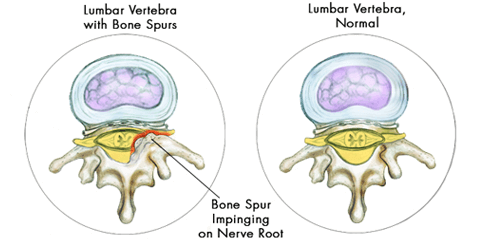What Causes Bone Spurs or Osteophytes
Aging, arthritis and ligament issues are the most common bone spurs causes. A bone spur, also known as osteophyte, is just extra bone. When a cartilage in your body breaks down, a bone spur occurs as a result of your body attempting to repair the damage. This is why new bone is created around the edges of existing bones.
A bone spur is, in essence, a small outgrowth of the bone. They tend to form where bones meet each other, as well as on the bones of your spine. Several causes can lead to a bone spur, but they are often associated with your body’s response to cartilage break down.
What Causes Bone Spurs
Primarily, bone spurs occur due to continued rubbing or stress of a bone. Another common cause of bone spurs is osteoarthritis or tendonitis. Bone spurs occur whenever a cartilage gets worn away, and the bones next to it begin rubbing directly against each other.
Other conditions are also associated with bone spurs. Some of these conditions include plantar fasciitis, which causes inflammation of the connective tissue on the bottom of the foot, exactly where it attaches to the heel bone. Other conditions include ankylosing spondylitis and diffuse idiopathic skeletal hyperostosis (DISH), which are both inflammatory conditions that affect the ligaments causing bone spurs in the spine.

Where Do Bone Spurs Occur
The majority of bone spurs develop in areas of injury or inflammation near tendons and cartilages. The most common location for bone spurs include the heel of the foot or the sole. Also on the back, around joints with degenerated cartilage, and in the spine near degenerated discs. In certain cases, bone spurs can also grow around the knee and shoulders.
What Are the Symptoms of Bone Spurs
Since they can occur in different areas of the body, bone spur symptoms will vary according to the area they occur. Some bone spurs cause no symptoms whatsoever, while others can cause loss of motion and acute pain.
Symptoms according to the location of the bone spur include:
- Knees – can cause pain when extending or bending the legs.
- Spine – can cause pain, numbness or weakness in arms or legs due to pinching of the spinal cord or the nerve roots.
- Hip – can cause pain and reduce the range of motion in the hip joint.
- Shoulders – can cause reduced shoulder movement, tears in the rotator cuff, and swelling.
- Fingers – can cause lumps under the skin.
Treatment for Bone Spurs
Because bone spurs are often the outcome of other degenerative conditions, stress, or injuries, there are unavoidable. Keeping an active, healthy lifestyle and being in good physical conditions can help reduce the symptoms associated with bone spurs. Maintaining a healthy weight can help ease the burden on the joints, decreasing the development of bone spurs. This is particularly true in the knees and feet. If non-conservative bone spur treatments do not show improvements in your symptoms, surgical treatment may be required.
The Bonati Spine Institute encourages patients with bone spurs to contact us to request a no-obligation MRI review or discuss your conditions with our medical professionals. Find out why The Bonati Spine Procedures are considered to be among the world’s best solutions when it comes to advanced spinal surgery. Your pain from bone spurs can become a thing of the past.
